Click on thumbnail to go to full size image.
This gallery shows diagrams presented in a talk at TSG2002 at Leicester in January.
 Fig.
1 - Some possible relationships between folds and thrusts. The problem with existing fault-bend
and fault-propagation fold models is that they fail to predict growth fans in syn-tectonic sediments
- a general feature of these sediments. Trishear makes better predictions. Fig.
1 - Some possible relationships between folds and thrusts. The problem with existing fault-bend
and fault-propagation fold models is that they fail to predict growth fans in syn-tectonic sediments
- a general feature of these sediments. Trishear makes better predictions. |
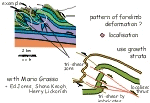 Fig.
2 - The Trishear model explains forelimb deformation - in general terms - as represented by fault
arras in these areas for example. But how is strain localised into the forelimb? Is there a simple
predictable pattern? Is it consistent along a particular structure? This issue is important for
making fracture predictions in compression structures on the basis of large scale geometry. Aim
here is to explore evolution of a fold-thrust complex - using syn-tectonic sediments. Fig.
2 - The Trishear model explains forelimb deformation - in general terms - as represented by fault
arras in these areas for example. But how is strain localised into the forelimb? Is there a simple
predictable pattern? Is it consistent along a particular structure? This issue is important for
making fracture predictions in compression structures on the basis of large scale geometry. Aim
here is to explore evolution of a fold-thrust complex - using syn-tectonic sediments. |
 Fig.
3 - The location is Sicily - a thrust belt which is generally southward-directed and which has
excellent syn-tectonic sedimentary successions. Fig.
3 - The location is Sicily - a thrust belt which is generally southward-directed and which has
excellent syn-tectonic sedimentary successions. |
 Fig.
4 - Simplified syn-tectonic stratigraphy for thrust-top basins in central Sicily - together with
dated levels in the section. High resolution stratigraphy like this provides a good way of calibrating
deformation. Fig.
4 - Simplified syn-tectonic stratigraphy for thrust-top basins in central Sicily - together with
dated levels in the section. High resolution stratigraphy like this provides a good way of calibrating
deformation. |
 Fig.
5 - The high resolution stratigraphy is exemplified best by the Messinian strata. Field and mine
data (from synclines) may be combined to show how successions are tightly controlled by the thrust-top
basin structure. The main sequence shows a model of how evaporite fractionation can occur. Fig.
5 - The high resolution stratigraphy is exemplified best by the Messinian strata. Field and mine
data (from synclines) may be combined to show how successions are tightly controlled by the thrust-top
basin structure. The main sequence shows a model of how evaporite fractionation can occur. |
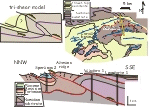 Fig.
6 - So - to explore the Trishear model we examine the Altesina backthrust system in central Sicily. Fig.
6 - So - to explore the Trishear model we examine the Altesina backthrust system in central Sicily. |
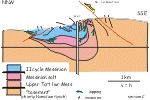 Fig.
7 - A detailed section through the syn-tectonic sediments at the outcrop of the Altesina back thrust
zone. This is based on surface data and a single well (indicated). Fig.
7 - A detailed section through the syn-tectonic sediments at the outcrop of the Altesina back thrust
zone. This is based on surface data and a single well (indicated). |
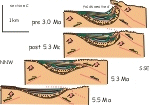 Fig.
8 - The evolution of the cross-section can be deduced from the thickness and lap relationships
in the syn-tectonic sediments. Notice how the locus of deformation (either by folding or faulting)
migrates on the southern flank of the basin, particularly in creating and then folding the thrust. Fig.
8 - The evolution of the cross-section can be deduced from the thickness and lap relationships
in the syn-tectonic sediments. Notice how the locus of deformation (either by folding or faulting)
migrates on the southern flank of the basin, particularly in creating and then folding the thrust. |
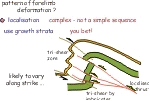 Fig.
9 - So to conclude first - the localisation of shear in the forelimb area (and associated thrusts)
is a complex sequence. Fig.
9 - So to conclude first - the localisation of shear in the forelimb area (and associated thrusts)
is a complex sequence.
|
 Fig.
10 - This map shows the basin in the "footwall" to the altesina thrust zone - with lines
of serial sections indicated (plus wells). Fig.
10 - This map shows the basin in the "footwall" to the altesina thrust zone - with lines
of serial sections indicated (plus wells). |
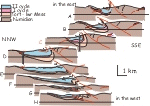 Fig.
11 - Serial sections through the basin. Fig.
11 - Serial sections through the basin. |
 Fig.
12 - Cross-sections constructed by EMS through the Mandre mine area - based on boreholes. An example
of the good subsurface control in the evaporite basins. Fig.
12 - Cross-sections constructed by EMS through the Mandre mine area - based on boreholes. An example
of the good subsurface control in the evaporite basins. |
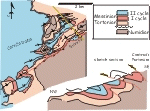 Fig.
13 - The thrust-fold complex continues ton the west where it is represented by an array of folds
that face to the north. Future work is planned to relate these into the subsurface at Corvillo. Fig.
13 - The thrust-fold complex continues ton the west where it is represented by an array of folds
that face to the north. Future work is planned to relate these into the subsurface at Corvillo. |
|
